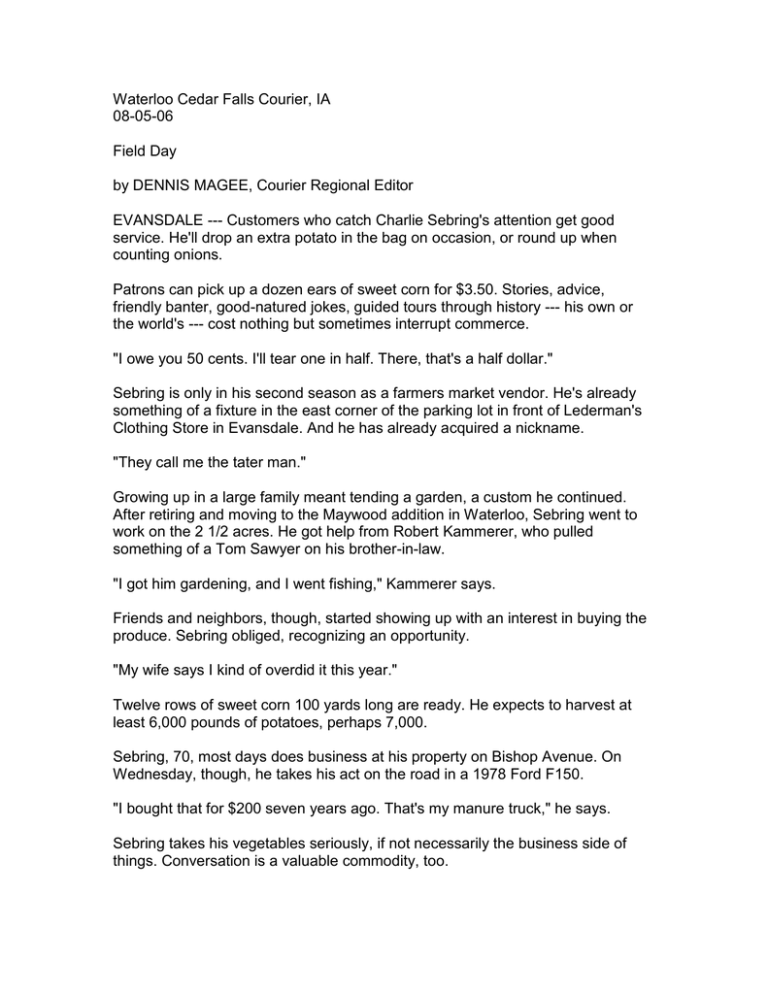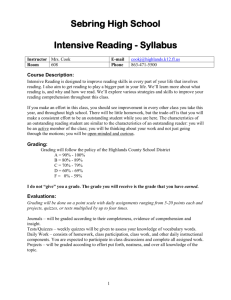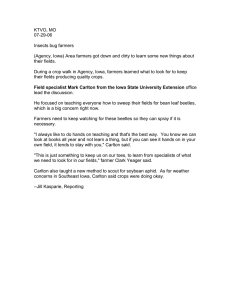Waterloo Cedar Falls Courier, IA 08-05-06 Field Day
advertisement

Waterloo Cedar Falls Courier, IA 08-05-06 Field Day by DENNIS MAGEE, Courier Regional Editor EVANSDALE --- Customers who catch Charlie Sebring's attention get good service. He'll drop an extra potato in the bag on occasion, or round up when counting onions. Patrons can pick up a dozen ears of sweet corn for $3.50. Stories, advice, friendly banter, good-natured jokes, guided tours through history --- his own or the world's --- cost nothing but sometimes interrupt commerce. "I owe you 50 cents. I'll tear one in half. There, that's a half dollar." Sebring is only in his second season as a farmers market vendor. He's already something of a fixture in the east corner of the parking lot in front of Lederman's Clothing Store in Evansdale. And he has already acquired a nickname. "They call me the tater man." Growing up in a large family meant tending a garden, a custom he continued. After retiring and moving to the Maywood addition in Waterloo, Sebring went to work on the 2 1/2 acres. He got help from Robert Kammerer, who pulled something of a Tom Sawyer on his brother-in-law. "I got him gardening, and I went fishing," Kammerer says. Friends and neighbors, though, started showing up with an interest in buying the produce. Sebring obliged, recognizing an opportunity. "My wife says I kind of overdid it this year." Twelve rows of sweet corn 100 yards long are ready. He expects to harvest at least 6,000 pounds of potatoes, perhaps 7,000. Sebring, 70, most days does business at his property on Bishop Avenue. On Wednesday, though, he takes his act on the road in a 1978 Ford F150. "I bought that for $200 seven years ago. That's my manure truck," he says. Sebring takes his vegetables seriously, if not necessarily the business side of things. Conversation is a valuable commodity, too. Big little business Farmers markets may seem harmless enough. A few ambitious backyard gardeners, like Sebring, offer up the standards: tomatoes, carrots, bell peppers, cucumbers, green beans, onions ... "Most people are looking for the things they are familiar with," vendor Denise Hoffman says. Just as predictably, each gathering of producers also will include some combination of the unexpected: daikon radishes, purple cauliflower, okra, raspberry mint vinegar, garlic, two-foot hostas ready to plant, boots with flowers growing where toes should be ... Daniel Otto, an economics professor at Iowa State University, published a work in March 2005 that suggests appearances may deceive. Farmers markets in Iowa are big business. His study, with graduate student Theresa Varner, determined the sidewalk sales and parking lot events generated about $20 million in 2004. The figure is based on what buyers said they were spending. But the money also churned through communities. So farmers markets in 2004, Otto said, also could reasonably be credited with an even larger economic impact on the state. The impressive results are despite the fact nearly half of customers surveyed, 47 percent, reported spending less than $10 per visit at a market. Only 12 percent reported spending more than $30. Evidence indicates farmers markets are flourishing. In his study, the professor notes an estimate more than a decade old. At that time, farmers markets generated $5 million to $5.5 million in sales in Iowa. Within about 10 years, the number of farmers markets in Iowa increased by 60 percent, and Otto said Iowa maintained the largest number per capita in the United States. In 2004, the state supported 180 markets. Definition of fresh Hoffman produces fruits and vegetables with her husband, Greg. The couple manages 20 acres along Martin Road in Waterloo. She suspects what ISU researchers confirmed. "I think the markets are growing, especially on Saturday," she says. In an average week, the Hoffmans pop the winged doors on their mobile produce stand at five markets in four days. From 3:30 to 5:30 p.m. Wednesday, the vehicle is parked near the Broom Factory Restaurant in Cedar Falls. The group formerly gathered near Earl May Garden Center on University Avenue. "This is new this year, so we're still trying to get people to know us," Hoffman says. Expectations undoubtedly moved, too. Customers uniformly give one reason for going to a farmers market in the first place: They want fruits and vegetables pulled straight from the stalk, tree and vine. "Are they fresh?" a patron asks Sebring, who is bent over four crates of potatoes. "These were dug yesterday. These I dug this morning," Sebring says. The customer settles on five pounds of today's find. Fresh rules, even when measured in hours. "That's part of the farmers market thing," Hoffman says. "It's fresh, not shipped from who knows where." The tricky part, she adds, is knowing from day to day and summer to summer what will trip a buyer's fancy. And then making sure an appropriate quantity is available when that person walks up. "No cilantro today. I'm sorry," Hoffman says. Lee Cronkhite, part owner and general manager of Pablo's Mexican Grill in Cedar Falls, will likely return. He is a regular in the Broom Factory parking lot, in part because his restaurant is only a few blocks away. "If you live in Iowa, it's ridiculous to buy from California, especially during the peak of the growing season," Cronkhite says. He fills a grocery bag with purple bell peppers, which will go from garden to meal in less than a day. His interest in the farmers market goes deeper, however, "We want to support the community that supports us," he says. The statement echoes professor Otto's findings. Customers like visiting farmers markets, even though other businesses exist and lower prices are likely available. Jacinda Canfield of Hudson hands cash to vendor Bridget Brown. She needs vegetables and earlier was at a big-box retail store. " ... And I didn't get them there," she says. Connections develop between the people who grow the food and those who eat it. Sebring greets patrons to the Evansdale market and neighboring vendors like, well, neighbors. A family from Bosnia manages the next booth in line. Beyond them, two women from the Philippines offer garden goods. Buyers and sellers know one another and bits about life stories. "Only once in awhile somebody pops up who we haven't seen before, a passerby," gardener Emy Lavenz says. Sebring thought when he retired most days would be spent in leisure. Instead, he planted a garden. A big garden. Six days a week he hoes, then harvests and hawks. For his effort, Sebring estimates he makes about $5 an hour. "But what do you make down on the bank fishing?" Contact Dennis Magee at (319) 291-1451 or dennis.magee@wcfcourier.com.




